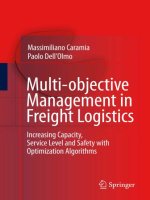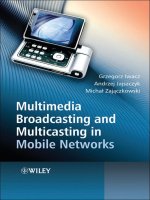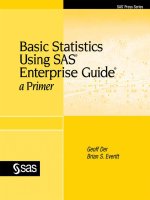Cambridge university emerging technologies in wireless LANs nov 2007 ISBN 0521895847 pdf
Bạn đang xem bản rút gọn của tài liệu. Xem và tải ngay bản đầy đủ của tài liệu tại đây (17.66 MB, 897 trang )
This page intentionally left blank
Emerging Technologies in Wireless LANs
Wireless LANs have become mainstream over the last few years. What started out as cable replacement for static desktops in indoor networks has been extended to fully mobile broadband applications
involving moving vehicles, high-speed trains, and even airplanes. An increasing number of municipal
governments around the world and virtually every major city in the United States are financing the
deployment of 802.11 mesh networks, with the overall aim of providing ubiquitous Internet access
and enhanced public services. This book is designed for a broad audience with different levels of
technical background and can be used in a variety of ways: as a first course on wireless LANs, as a
graduate-level textbook, or simply as a professional reference guide. It describes the key practical
considerations when deploying wireless LANs and equips the reader with a solid understanding of the
emerging technologies. The book comprises 38 high-quality contributions from prominent
practitioners and scientists, and covers a broad range of important topics related to 802.11 networks,
including quality of service, security, high-throughput systems, mesh networking, 802.11/cellular
interworking, coexistence, cognitive radio resource management, range and capacity evaluation,
hardware and antenna design, hotspots, new applications, ultra-wideband, and public wireless
broadband.
“Benny Bing has created a masterful, horizon-to-horizon compendium covering the foundations,
functionality, implementation, and potential-for-the-future of IEEE 802.11 wireless LAN communications. Whether your interests are in QoS, security, performance and throughput, meshing and
internetworking, management and design, or just the latest in Wi-Fi applications, you will find an indepth discussion inside these covers. Emerging Technologies in Wireless LANs: Theory, Design, and
Deployment is an excellent resource for anyone who wants to understand the underpinnings and
possibilities of the Wi-Fi offerings we see evolving in the marketplace today.”
– Robert J. Zach, Director, Next Generation Broadband, EarthLink, Inc., USA
“Over the past 20 years, wireless LANs have grown from technical curiosity to a mainstream
technology widely installed across residential, enterprise, and even municipal networks. The mobility
and convenience of wireless has been augmented by the advanced throughput and range performance
available in today’s products, extending the reach of wireless LANs to a broad array of applications.
This book explores all aspects of contemporary wireless LANs, from the basics through wireless
security, meshes, QoS, high throughput, and interworking with external networks. The broad range of
topics and perspective make this the ideal reference for experienced practitioners, as well as those
new to the field.”
– Craig J. Mathias, Principal, Farpoint Group, USA
“This book is a wonderful resource for anyone who works with Wi-Fi wireless technologies. It
provides an excellent overview for the newcomer and an extensive and up-to-date reference for the
expert. This book is a crucial tool for everyone involved in this exciting, fast-paced field. Everyone
will learn from it!”
– Professor David F. Kotz, Director, Center for Mobile Computing, Dartmouth College, USA
“The ability of Wi-Fi technology to expand in so many directions while maintaining backwards
compatibility has been one key to its success and the technology will certainly continue to evolve.
This book has hopefully given you some insights into where we have been and where we may be
headed.”
– Greg Ennis, Technical Director, Wi-Fi Alliance
Benny Bing is a research faculty member with the School of Electrical and Computer Engineering,
Georgia Institute of Technology. He is an IEEE Communications Society Distinguished Lecturer,
IEEE Senior Member, and Editor of the IEEE Wireless Communications magazine.
Emerging Technologies in Wireless LANs
Theory, Design, and Deployment
Edited by
BENNY BING
Georgia Institute of Technology
CAMBRIDGE UNIVERSITY PRESS
Cambridge, New York, Melbourne, Madrid, Cape Town, Singapore, São Paulo
Cambridge University Press
The Edinburgh Building, Cambridge CB2 8RU, UK
Published in the United States of America by Cambridge University Press, New York
www.cambridge.org
Information on this title: www.cambridge.org/9780521895842
© Cambridge University Press 2008
This publication is in copyright. Subject to statutory exception and to the provision of
relevant collective licensing agreements, no reproduction of any part may take place
without the written permission of Cambridge University Press.
First published in print format 2007
eBook (NetLibrary)
ISBN-13 978-0-511-37105-9
ISBN-10 0-511-37105-5
eBook (NetLibrary)
hardback
ISBN-13 978-0-521-89584-2
hardback
ISBN-10 0-521-89584-7
Cambridge University Press has no responsibility for the persistence or accuracy of urls
for external or third-party internet websites referred to in this publication, and does not
guarantee that any content on such websites is, or will remain, accurate or appropriate.
All trademarks mentioned in this publication are the property of the respective owners. Use
of a term in this publication should not be regarded as affecting the validity of any
trademark or service mark. While the publisher, editor, and contributors have used their
best efforts in preparing this publication, they make no representation or warranties with
respect to the accuracy or completeness of this publication and specifically disclaim any
implied warranties of merchantability or fitness for a particular purpose. No warranty may
be created or extended by sales representatives or written sales materials. The advice and
strategies contained herein may not be suitable for your situation. You should consult with
a professional where appropriate. Neither the publisher, editor, or contributors shall be
liable for any loss of profit or any other commercial damages, including but not limited to
special, incidental, consequential, or other damages.
Contents
Authorship by Chapter
Foreword
Preface
page xxix
xxxiii
xxxv
Part I: Introduction to 802.11
Chapter 1 - Emerging IEEE 802.11 Standards
1.1 IEEE 802.11n: Enhancements for Higher Throughput
1.1.1 802.11n PHY
1.1.1.1 MIMO
1.1.1.2 40 MHz Channel Binding
1.1.1.3 Beam Forming
1.1.1.4 STBC
1.1.1.5 Other 802.11n PHY Features
1.1.2 802.11n MAC
1.1.2.1 High Throughput Support
1.1.2.2 Legacy Protection, Coexistence, and Interoperability
1.2 IEEE 802.11k: Radio Resource Measurement
1.3 802.11p: Wireless Access for the Vehicular Environment
1.4 802.11r: Fast BSS-Transitions
1.5 802.11s: Wireless Mesh Networks
1.6 802.11T: Wireless Performance Prediction
1.7 802.11u: Wireless Inter-working with External Networks
1.8 802.11v: Wireless Network Management
1.9 802.11w: Management Frame Protection
1.10 802.11y: Contention Based Protocol
1.11 Conclusions
1
1
2
2
2
2
3
3
4
4
6
6
7
8
8
9
10
10
11
11
12
Chapter 2 - Guide to Wireless LAN Analysis
2.1 Introduction
2.2 Overview of Wireless LANs
2.2.1 WLAN Physical-Layer Standards
2.2.1.1 802.11n
2.2.2 WLAN Regulation
2.2.3 WLAN Topologies
2.2.4 Establishing a wireless connection
2.2.4.1 Discovery
13
13
13
14
14
15
16
17
18
vi
Contents
2.2.4.2 Authentication and deauthentication
2.2.4.3 Association, disassociation, and reassociation
2.2.4.4 Confidentiality
2.2.5 Security
2.2.5.1 Concepts of secure communications
2.2.5.2 Confidentiality and encryption
2.2.6 Collision Avoidance and Media Access
2.2.7 Physical Layer
2.2.7.1 Radio frequencies and channels
2.2.7.2 Signal and noise measurement
2.2.7.3 Encoding and data rates
2.2.8 Packet Structure and Packet Type
2.2.8.1 Data Packet Structure
2.2.8.2 Management and Control Packets
2.3 Wireless Network Analysis
2.3.1 Planning and designing a WLAN
2.3.1.1 Predeployment
2.3.1.2 Initial deployment
2.3.2 Managing a WLAN
2.3.2.1 Managing Signals
2.3.2.2 Managing Users
2.3.3 Administering a WLAN
2.3.3.1 Securing the WLAN
2.3.4 Troubleshooting - Analyzing Higher Level Network Protocols
2.3.4.1 Leveraging existing assets with AP Capture Adapters
2.4 Conclusion
18
18
19
19
19
20
22
24
24
26
27
28
28
29
29
30
31
32
32
32
32
34
34
36
37
38
Part II: 802.11 Quality of Service
Chapter 3 - WLAN QoS
3.1 Introduction
3.1.1 Terminology and Abbreviations
3.2 Channel Access
3.2.1 Legacy Channel Access Methods
3.2.1.1 Legacy Contention-Based Channel Access
3.2.1.2 Legacy Polled Access Protocol
3.2.2 802.11e Contention-Based Channel Access
3.2.2.1 TCMA MAC Protocol
3.2.3 802.11e Polled Channel Access
3.2.4 Illustrative Examples
3.3 Admission Control
3.3.1 Admission Control for Contention-Based Channel Access
3.3.2 Admission Control for Polled Channel Access
3.4 Power Management
3.4.1 Legacy Power-Save Mechanism
39
39
40
41
42
42
42
43
45
46
48
49
50
51
51
52
Contents
3.5
3.6
3.7
3.7
3.4.2 Automatic Power Save Delivery
3.4.2.1 Scheduled APSD
3.4.2.2 Full Unscheduled APSD
3.4.2.3 Hybrid Unscheduled APSD
3.4.2.4 Illustrative Examples
QoS in Wireless Mesh Networks
Summary
End Note
References
vii
53
53
54
55
56
57
59
59
61
Chapter 4 - Performance Understanding of IEEE 802.11 DCF and
IEEE 802.11e EDCA
4.1 Introduction
4.2 IEEE 802.11 MAC Protocol
4.2.1 DCF Overhead
4.3 Performance evaluation of the IEEE 802.11 DCF
4.3.1 The Concept of Saturation Throughput
4.3.2 Maximum Saturation Throughput
4.3.2.1 Performance Bounds for 802.11b DCF
4.3.3 Saturation Throughput Analysis
4.3.3.1 Throughput Performance
4.3.3.2 Delay Performance
4.3.4 Non-Ideal Channel Conditions
4.4 MAC Enhancements for QoS Support
4.4.1 IEEE 802.11e EDCA
4.4.2 Further QoS Enhancement for Ad-Hoc Networks
4.5 Performance understanding of IEEE 802.11e EDCA
4.5.1 CWmin Differentiation
4.5.2 AIFS Differentiation
4.5.3 Coexistence of EDCA AC_BE and legacy DCF stations
4.5.3.1 Backoff Counter Decrement Rules
4.5.3.2 Analysis of AC_BE Default Settings
4.5.3.3 AIFSN=2 and Legacy DCF Stations
4.6 Conclusion
4.7 References
63
63
64
67
69
69
71
74
76
80
82
85
86
86
89
89
91
92
95
96
98
99
101
101
Chapter 5 - Cross-layer Optimized Video Streaming over Wireless
Multi-hop Mesh Networks
5.1 Introduction
5.2 Proposed integrated cross-layer video streaming
5.2.1 Wireless Multi-hop Mesh Topology Specification
5.2.2 Link and Path Parameter Specification
5.2.3 Application and Network-layer Parameter Specification
5.3 Problem Formulation
5.4 Video Streaming Optimization in the Multi-hop Mesh Network
5.4.1 End-to-End Optimization
105
105
107
109
110
111
112
114
114
viii Contents
5.5
5.6
5.7
5.8
5.9
5.10
5.4.2 Optimization under a certain Horizon of Network Information
Complexity and Information Requirements of the Different Alternatives
Experimental Results
Further Reading
Conclusions
Appendix
References
115
119
121
124
125
126
127
Part III: 802.11 Security
Chapter 6 - Understanding and Achieving Next-Generation Wireless Security
6.1 Overview
6.2 Risks of Wireless Insecurity
6.3 Understanding Wi-Fi Protected Access (WPA)
6.3.1 WPA TKIP
6.3.2 802.1X - User Authentication and Network Access
6.3.3 WPA Cracking Tools
6.3.4 WPA Summary
6.4 The Way Forward: Wi-Fi Protected Access 2 (WPA2) and 802.11i
6.4.1 Increased Density of Access Points
6.4.2 Roaming Wireless Clients
6.4.3 Failover Requirements
6.5 WPA2: Under the Covers
6.5.1 WPA2 and 802.1X
6.5.2 WPA2 and TKIP
6.5.3 WPA2 and CCMP
6.5.4 WPA2 and Fast Roaming
6.5.4.1 PMK Caching
6.5.4.2 Pre-Authentication
6.6 Opportunistic PMK Caching: Fast Roaming at Its Fastest
6.7 Summary
131
131
132
132
133
134
134
135
135
136
136
136
137
137
139
139
140
140
141
141
143
Chapter 7 - Wireless Local Area Network Security
7.1 Introduction
7.2 Current Application Solutions
7.3 MAC-Level Encryption Enhancements
7.3.1 The TKIP Per-Packet Hash Function
7.3.2 TKIP Temporal Key Derivation
7.3.3 Message Integrity Code
7.3.4 AES Based Encryption and Data Authentication
7.4 Secret Key Distribution and Generation
7.5 Authentication
7.5.1 802.1x EAP Authentication
7.5.2 EAP-MD5
7.5.3 EAP-TTLS
145
145
146
147
147
148
149
149
150
151
151
152
153
Contents
7.5.4 IEEE 802.11 and RADIUS MAC Authentication
7.6 Evolution, Standards, and Industry Efforts
7.6.1 Security-related changes in the TGn High Throughput Amendment
7.6.2 Security-related changes in the TGr Fast BSS Transition Amendment
7.6.3 Security in the TGs Mesh Amendment
7.6.4 Security in the TGw Protected Management Frames Amendment
7.7 Wireless and Software Vulnerabilities
7.7.1 Exploiting Wireless Device Drivers
7.7.2 Discovering Driver Vulnerabilities
7.7.3 Exploiting Driver Vulnerabilities
7.7.4 Mitigating Driver Vulnerabilities
7.8 Wireless Intrusion Detection
7.8.1 Deployment Models
7.8.1.1 WIDS Overlay Deployment Model
7.8.1.2 WIDS Integrated Deployment Model
7.8.2 Analysis Techniques
7.8.2.1 Signature Analysis
7.8.2.2 Trend Analysis
7.8.2.3 Anomaly Analysis
7.8.3 Upper-Layer Analysis Mechanisms
7.8.4 Wireless Countermeasures
7.8.4.1 Adversary Denial of Service
7.8.4.2 Role-Based Access Control Measures
7.9 References
ix
153
154
154
154
154
157
157
157
159
163
164
166
167
167
167
168
168
170
171
172
174
174
175
176
Part IV: High Throughput 802.11
Chapter 8 - The 802.11n Standard
8.1 Introduction
8.2 IEEE 802.11n
8.3 Preambles
8.4 802.11n Transmitter
8.5 LDPC Coding
8.6 Space Time Block Coding
8.7 Beamforming
8.8 MAC Enhancements
8.9 Use of 40 MHz Channels
8.10 MIMO-OFDM Performance Results
8.11 References
179
179
180
180
185
186
187
188
188
189
189
192
Chapter 9 - MIMO Spatial Processing for 802.11n WLAN
9.1 Introduction
9.2 MIMO OFDM System Overview
9.3 Spatial Spreading
9.4 Transmit Beamforming
193
193
193
196
197
x
9.5
9.6
9.7
9.8
9.9
Contents
9.4.1 Eigenvector Beamforming
9.4.2 Channel Sounding and Calibration
Receiver Structures
9.5.1 Near-Optimal Iterative Receiver
9.5.2 List Sphere Decoding
9.5.3 Linear Receivers
Comparison of Spatial Spreading and Transmit Beamforming
9.6.1 Simulation Setup
9.6.2 Throughput vs Range Performance
9.6.3 Packet Error Rate Performance
Complexity Analysis
9.7.1 MMSE Processing
9.7.2 Cholesky Decomposition
9.7.3 LSD Search
9.7.4 LSD Max-log-MAP
9.7.5 Per-Stream LLR Computation
9.7.6 Viterbi Decoding
9.7.7 Examples
Conclusions
References
197
198
201
201
203
203
204
205
206
206
207
211
211
211
212
212
212
213
214
215
Part V: 802.11 Mesh Networks
Chapter 10 - Capacity of Wireless Mesh Networks
10.1 Introduction
10.2 Terminology
10.3 Single-radio Shared Wireless Mesh
10.4 Dual-Radio Shared Wireless Mesh
10.5 Multi-Radio Switched Wireless Mesh
10.6 Conclusion
10.7 Appendix: Capacity analysis for single, dual, multi-radio meshes
10.7.1 String of pearls, mesh portal on one end
10.7.1.1 Single-radio
10.7.1.1.1 Lower bound
10.7.1.1.2 Upper bound
10.7.1.2 Dual-radio
10.7.1.2.1 Lower bound
10.7.1.2.2 Upper bound
10.7.1.3 Multi-Radio
10.7.2 String of pearls, mesh portal in middle
10.7.2.1 Single-radio
10.7.2.1.1 Lower bound
10.7.2.1.2 Upper bound
10.7.2.2 Dual-radio
10.7.2.2.1 Lower bound
217
217
219
219
223
225
229
230
230
230
231
231
231
232
232
232
232
232
233
233
233
233
Contents
10.7.2.2.2 Upper bound
10.7.2.3 Multi-Radios
10.7.3 Full mesh on rectilinear grid
10.7.3.1 Single-radio
10.7.3.1.1 Lower bound
10.7.3.1.2 Upper bound
10.7.3.2 Dual-radio
10.7.3.2.1 Lower bound
10.7.3.2.2 Upper bound
10.7.3.3 Multi-Radio
xi
234
234
234
236
236
236
236
236
237
237
Chapter 11 - Autonomous Mobile Mesh Networks and their Design Challenges
11.1 Introduction
11.2 Evolution of mobile mesh networks
11.3 Usage Scenarios for Mobile Mesh Networks
11.3.1 Mobile Mesh Networks for Public Safety Services
11.3.2 Disaster Relief Operations
11.3.3 Defense Network-centric Operations
11.3.4 Enterprise Applications
11.3.5 Logistics
11.3.6 Consumer/Home Networking
11.3.7 Transportation Applications
11.3.8 Video Surveillance
11.4 Performance Requirements for Mobile Mesh and Applications
11.4.1 General Performance Metrics for the Internet
11.4.2 Performance Metrics for Mobile Ad hoc Networks
11.5 Design Challenges for Mobile Mesh Networks
11.5.1 Physical Radio Channels
11.5.2 Medium and Mesh Network Access
11.5.3 Routing and Multicasting
11.5.4 Security
11.5.5 IP addressing
11.5.6 Roaming
11.5.7 Data Transfer Reliability
11.5.8 Quality of Service (QoS)
11.5.9 Network Management
11.5.10 Distributed Services in a Mobile Mesh
11.5.11 Applications
11.6 Conclusions
11.7 References
239
239
240
242
242
243
244
244
244
245
245
245
246
246
246
247
249
249
250
251
252
253
254
254
255
256
256
257
257
Chapter 12 – Service Provisioning for Wireless Mesh Networks
12.1 Introduction
12.2 Wireless Mesh Networks
12.3 Service Offerings
12.3.1 Free Internet Access (Unregistered)
261
261
262
263
265
xii
Contents
12.3.2 Free Internet Access (Registered)
12.3.3 Flat-Rate Fee-Based Public Access
12.3.4 Differentiated-Rate Fee-based Public Access
12.4 Web Filtering
12.5 Wireless Spectrum Preservation
12.6 Public Safety
12.7 Video Surveillance
12.8 Mobile Government Users
12.9 Virtual Private Networks (VPN)
12.10Voice over IP (VoIP)
12.11 Meter Reading
12.12 Government as Anchor Tenant
12.13 Dedicated Internet Access
12.14 Advanced Network Services
12.15 Conclusions
265
267
267
269
269
271
272
273
274
275
275
276
276
278
278
Chapter 13 - Metro-Scale Wi-Fi Networks
13.1 Introduction
13.2 Wireless Broadband Initiatives
13.3 Network Use Cases and Performance Requirements
13.4 Multi-Tier Network Design Overview
13.5 Wi-Fi Tier Design
13.6 Mesh Tier Design
13.7 Injection Tier Design
13.8 Network-wide Seamless Mobility Support
13.9 Conclusion
13.10 References
281
281
282
283
285
290
293
297
298
302
303
Chapter 14 - Usage and Performance Comparison of Mobile
MetroMesh Networks
14.1 MetroMesh Network Architecture
14.2 Predictive Wireless Routing Protocol (PWRP)
14.2.1 Scalable routing
14.2.2 Throughput-optimized routing
14.2.3 RF spectrum management
14.2.4 Multi-mode routing
14.2.5 Seamless session-persistent mobility
14.2.6 Dynamic rate-limiting and traffic management
14.2.7 Correlated Mesh Data Protocol (CMDP)
14.2.8 Patents
14.3 Overview of the Networks
14.3.1 Client Usage
14.3.2 Client Link Performance
14.3.3 Mesh Network Performance
14.4 Hourly Usage Patterns
14.4.1 For-Fee Network
307
307
309
309
309
309
310
310
310
311
311
311
311
312
312
314
314
Contents
xiii
14.4.2 Free Network
14.5 Summary
14.6 References
314
314
315
Chapter 15 - First, Second and Third Generation Mesh Architectures
15.1 Introduction
15.2 Three Generations of Mesh Architectures
15.3 Bandwidth degradation on Single Channel Backhauls
15.4 Latency/Jitter Degradation on Single Channel Backhauls
15.5 Frequency Agility
15.6 Radio Agnostic Mesh
15.7 New Applications Enabled by Third Generation Wireless Mesh
15.8 Conclusions
317
317
317
319
319
322
324
326
327
Chapter 16 - Wireless Mesh Networks
16.1 Introduction
16.1.1 History
16.1.2 The Benefits of Wireless Mesh Networking
16.1.3 Some Typical Deployment Scenarios
16.1.4 Other Wireless Solutions
16.2 Current Issues and Solutions
16.2.1 Network Structure
16.2.2 Intra-mesh Channel Re-use
16.2.3 Medium Access Contention
16.2.4 Mesh Routing and Forwarding
16.2.5 Mesh Security
16.2.6 Congestion Control
16.2.7 Fairness
16.2.8 UDP and TCP Performance
16.2.9 Voice over Mesh
16.2.10 Mesh Network Management
16.3 Mesh Deployment Issues
16.4 IEEE 802.11, Amendment “s”
16.4.1 Overview
16.4.2 The IEEE 802.11s Mesh Network Model
16.4.3 Mesh Discovery
16.4.4 Peer Link Establishment
16.4.5 Mesh Security
16.4.6 Routing Metrics
16.4.7 Routing and Metrics
16.4.8 Forwarding
16.4.9 Interworking
16.4.10 MAC Enhancements
16.5 Conclusion
16.6 References
329
329
329
330
330
332
332
333
333
333
334
336
338
338
339
339
341
341
342
342
343
343
344
344
345
345
347
347
348
348
349
xiv Contents
Part VI: 802.11/Cellular Interworking
Chapter 17 - WLAN Interworking with 2G/3G Systems
17.1 Introduction
17.2 Standards related activities
17.2.1 3GPP2
17.2.2 3GPP
17.3 WLAN Interworking Plumbing
17.3.1 WLAN Association
17.3.1.1 Scanning Process
17.3.1.2 Manual Scan Procedures
17.3.1.3 Automatic Scan Procedures
17.3.1.4 Access Point Sets Definition
17.3.1.5 Iterations in making WLAN system selection
17.3.1.6 Scan Types
17.3.1.7 Candidate Set Selection
17.3.1.8 RSSI Filtering
17.3.1.9 Time delay for subsequent scan event
17.3.1.10 Active Set Selection
17.3.2 WLAN De-Selection
17.3.2.1 In Traffic Operation
17.3.2.2. IP Address Assignment
17.3.3 PDIF Discovery Mechanisms
17.3.4 Tunnel establishment procedures
17.3.4.1 Error Scenario 1
17.3.4.2 Error Scenario 2
17.3.5 UDP encapsulation to support NAT Traversal
17.3.6 Acquiring configuration information
17.3.7 Rekeying Procedures
17.3.7.1 Rekeying of IKE_SA
17.3.7.2 Rekeying of CHILD_SA
17.3.8 Tunnel Disconnect Procedures
17.3.8.1 MS-initiated tunnel disconnection
17.3.8.2 PDIF-initiated tunnel disconnection
17.3.8.3 H-AAA-initiated tunnel disconnection
17.3.9 Application specific Child SA support
17.3.10 NAT Keep Alive and Dead-Peer Detection procedures
17.3.10.1 NAT Keep Alive
17.3.10.2 Dead Peer Detection (DPD)
17.3.11 Voice call establishment procedures
17.3.11.1 Procedures for the packet-switched domain
17.3.12 Supporting mobility without the VCC feature
17.3.12.1 Solutions supporting mobility
17.3.13 Voice Call Continuity
17.3.14 Domain Registration
17.3.14.1 IMS Registration in the IP-CAN domain
351
352
353
353
354
357
360
361
362
362
362
363
363
365
365
366
366
367
368
368
369
369
375
375
376
378
378
379
380
381
381
382
383
384
385
385
385
385
386
387
388
397
401
401
Contents
xv
17.3.14.2 Circuit-Switched Registration in the CS domain
17.3.15 Active Call Handoff
17.4 Mobility between the 2G/3G and WLAN domains
17.4.1 MS is paged over the non-preferred domain
17.4.1.1 Activation modes
17.4.1.2 WLAN Operating Modes
17.4.2 Entry and Exit criteria for 2G/3G and WLAN systems
17.4.2.1 GSM/GPRS/EDGE
17.4.2.2 Exit Criteria
17.4.3 UMTS
17.4.3.1 Entry Criteria
17.4.3.2 Exit Criteria
17.4.4 1xRTT
17.4.4.1 Entry Criteria
17.4.4.2 Exit Criteria
17.4.5 1xEV-DO
17.4.5.1 Entry Criteria
17.4.5.2 Exit Criteria
17.4.6 WLAN
17.4.6.1 Entry Criteria
17.4.6.2 Exit Criteria (with default values)
17.5 MS is paged over the non-preferred domain
17.6 Conclusion
17.7 References
17.8 Appendix A: NAT Types
17.8.1 What are the issues in handling VoIP without NAT Traversals?
17.9 Appendix B: Single and Dual Subscription
17.9.1 Dual subscription
17.9.2 Single Subscription
17.9.2.1 Single private identity
17.9.2.2 Two private identities
17.10 Glossary
402
405
412
414
415
416
417
417
418
418
418
418
418
418
419
419
419
419
419
419
419
419
420
421
422
423
423
424
424
425
425
426
Chapter 18 - Towards Service Continuity in Emerging Heterogeneous
Mobile Networks
18.1 Introduction
18.2 Related Work
18.3 Proposed Architecture
18.3.1 Solution Space
18.3.2 Mobility Security Association Bootstrapping
18.3.3 Performance Optimization
18.3.4 Traversing Network Address and Port Translators
18.4 Evaluation
18.4.1 Results
18.4.2 Analysis and Discussion
18.5 Conclusions
429
429
430
431
431
433
434
435
435
436
438
439
xvi Contents
18.6 References
439
Chapter 19 - A Survey of Analytical Modeling for Cellular/WLAN Interworking 441
19.1 Introduction
441
19.2 Cellular/WLAN Interworking Architectures
442
19.2.1 Loose Coupling Architecture
442
19.2.2 Tight Coupling Architecture
444
19.2.3 Hybrid Coupling Architecture
445
19.2.4 IMS Architecture for 3GPP/3GPP2-WLAN Interworking
446
19.3 Simple Models for Cellular/WLAN Interworking
448
19.3.1 Cellular/WLAN Model using Birth-Death Processes
448
19.3.1.1 Model Assumptions
448
19.3.1.2 Mobility Model
449
19.3.1.3 Traffic Equations in the Cellular Network
449
19.3.1.4 Traffic Equations in the WLAN
450
19.3.1.5 Performance Measures
451
19.3.2 Cellular/WLAN Model using Multidimensional Markov Chains
452
19.3.2.1 Model Assumptions
452
19.3.2.2 Performance Measures
453
19.4 Further Analytical Models for Cellular/WLAN Interworking
454
19.4.1 WLAN Capacity
454
19.4.2 Other Mobility Models
456
19.4.2.1 Non-uniform Mobility within a Single Cell
456
19.4.2.2 A Cell Residence Time Model for Two-Tier Integrated
Wireless Networks
456
19.4.3 Models with General Distributions
458
19.4.3.1 Traffic Equations of Handoff Rates
459
19.4.3.2 Channel Holding Times
461
19.5 Simulation Models
462
19.6 Open Issues
463
19.7 Conclusions
464
19.8 References
465
Part VII: Coexistence
Chapter 20 - Coexistence of Unlicensed Wireless Networks
20.1 Introduction
20.2 Overview of Unlicensed Frequency Bands
20.2.1 ISM and U-NII Frequency Bands
20.2.2 The 3650 MHz Frequency Band
20.2.3 VHF and UHF Television Frequency Bands
20.3 Survey of Unlicensed Wireless Networks
20.3.1 Wireless Local Area Network (WLAN)
20.3.2 Wireless Personal Area Network (WPAN)
20.3.3 Wireless Metropolitan Area Network (WMAN)
469
469
469
470
472
473
474
474
476
477
Contents xvii
20.3.4 Wireless Regional Area Network (WRAN)
20.3.5 Cordless Telephones
20.4 History of Wireless Coexistence
20.5 How to Evaluate the Coexistence of Wireless Networks
20.6 Methods of Improving Coexistence
20.7 Coexistence Assessment – IEEE 802.15.4b
20.8 Coexistence Assessment – Draft IEEE 802.11n
20.9 Dynamic Spectrum Access
20.10 Conclusions
20.11 References
478
479
479
480
486
488
489
491
498
499
Chapter 21 - Coexistence of IEEE 802.11n and Bluetooth
21.1 Introduction
21.2 Geometric Analysis
21.3 Temporal Analysis
21.4 Combined Geometric and Temporal Analysis
21.5 Conclusion
21.6 References
501
501
502
507
512
514
515
Part VIII: 802.11 Network and Radio Resource Management
Chapter 22 - Measured WLANs: The First Step to Managed WLANs
22.1 Introduction
22.2 802.11k Measurements
22.2.1 Beacon
22.2.2 Measurement Pilot
22.2.3 Frame
22.2.4 Channel Load
22.2.5 Noise Histogram
22.2.6 STA Statistics
22.2.7 Location
22.2.8 Measurement Pause
22.2.9 Neighbor Report
22.2.10 Link Measurement
22.2.11 Transmit Stream Measurement
22.3 The 11k Interface to Upper Layers
22.4 Impact of the 11k Standard
517
517
518
519
519
520
520
520
520
520
520
521
521
521
521
522
Chapter 23 - Cognitive WLAN: A Better Architecture
23.1 Introduction
23.2 Evolution of a Cognitive WLAN
23.2.1 WLAN Architecture – Independent APs
23.2.2 WLAN Architecture – Dependent APs
23.3 Cognitive WLAN Architecture
23.3.1 Cognitive WLAN Goals
523
523
525
526
527
529
529
xviii Contents
23.3.2 Components of a Cognitive WLAN
23.3.2.1 Clustering
23.3.2.2 RF Analysis
23.3.2.3 Integrity Management
23.4 Features and Benefits of the Architecture
23.5 The Vision for the Future
531
531
531
532
533
533
Part IX: 802.11 Range
Chapter 24 - Wi-Fi Range: Impact on Data Rates, Coverage, and Capacity
24.1 Introduction
24.2 Defining Range and Coverage
24.3 Range Basics
24.4 Antenna Design
24.5 Range and Coverage
24.6 Range Limiting Factors
24.6.1 Interference
24.6.2 Multi-Path
24.6.3 Attenuation
24.6.4 Hidden Node
24.7 Signal to Noise Ratio
24.8 Range versus Capacity
24.9 Site Surveys and Dead Spots
24.10 Future Technologies
24.11 Long Range Wi-Fi Case Study
24.12 Summary
535
535
535
536
537
539
539
539
540
541
542
543
544
546
547
549
550
Part X: 802.11 Hardware Design
Chapter 25 - An 802.11g WLAN System on a Chip
25.1 Introduction
25.2 Architecture
25.3 Implementation
25.3.1 Receiver
25.3.2 Transmitter
25.3.3 Synthesizer
25.4 SoC Integration
25.4.1 Calibration
25.4.2 Noise isolation
25.5 Experimental Results
25.6 Conclusion
25.7 References
551
551
552
553
553
554
556
557
557
557
558
561
561
Contents
Chapter 26 - Antenna Design for Portable Computers
26.1 Introduction
26.1.1 Source of radiation
26.1.2 Factors Affecting Small Antenna Design
26.1.2.1 Conductor Area
26.1.2.2 Radiation Resistance
26.1.2.3 Radiation Efficiency
26.1.2.4 Antenna Q
26.1.3 Fundamental Limits of Electrically Small Antennas
26.1.3.1 Chu-Harrington Limit on Q
26.1.3.2 Fundamental Gain Limitation
26.1.3.3 Qualification Metrics
26.1.3.4 Q-Volume Space
26.1.3.5 Q-Volume Space: Example Antennas
26.1.4 WLAN/WWAN Antenna Requirements
26.1.4.1 Secondary Design Considerations
26.1.4.2 Antenna Location Selection
26.1.4.3 Example Gain and Radiation Patterns
26.2 Power Statistics of Small Scale Fading in Rayleigh Radio Channels
26.3 Diversity Architectures
26.4 Rician Channel Power Statistics
26.4.1 Diversity Gain of Omni-Antennas in Rician Channels
26.4.2 Diversity Gains of Multiple Antennas under Rician Fading
26.5 Conclusion
26.6 References
xix
563
563
564
565
565
566
566
567
567
567
568
569
569
570
571
572
572
573
576
578
581
583
585
586
586
Part XI: Wi-Fi Hotspots
Chapter 27 - Service Control and Service Management of Wi-Fi Hotspots
27.1 Wi-Fi Hotspots Introduction
27.2 Brief History of Hotspots
27.2.1 Overview of Commericial Hotspots
27.2.2 Overview of Free Hotspots
27.2.3 Wi-Fi Hotspot Signal Range
27.2.4 Advantages of Wi-Fi
27.3 Service Management - Overview
27.3.1 Hotspot Service Management
27.3.2 Importance of Service Management
27.3.3 Network and Data Management Services
27.3.4 Obtaining a Network Address
27.3.5 Obtaining a Host Address
27.3.6 Authentication, Authorization and Accounting for Hotspots
27.3.6.1 Authentication
27.3.6.2 Authorization
27.3.6.3 Accounting
589
589
589
589
590
591
591
592
592
593
593
594
594
595
595
596
596
xx
Contents
27.3.7 User Login Page
27.4 QoS Services
27.4.1 Per User QoS
27.4.2 Service Level Agreements (SLA)
27.4.2.1 Packages
27.4.2.2 Price Plan
27.4.2.3 Prepaid Cards
27.4.3 Billing and Payment
27.4.4 Network monitoring
27.4.5 Customer Care
27.4.6 Reports
27.4.7 Alerts
27.4.8 Contracts and Tariffs
27.5 Wi-Fi Network Designs
27.5.1 Centralized Control over Services for Wi-Fi Networks
27.5.2 Virtual partitioning of wireless network for different types of users
27.5.3 Additional revenue generation opportunities
27.5.4 Session Intercepts and “Hot-Lining”
27.6 Lawful Intercept for Communications Assistance for Law Enforcement Act
27.7 Security in Wi-Fi
27.7.1 Security Benefits
27.7.1.1 Data privacy
27.7.1.2 Authentication
27.7.1.3 Reliability
27.8 Future Technologies
27.8.1 Mobile Hotspots
27.8.2 Managed Services Platform
27.8.3 Wi-Max
27.8.4 Virtual Network Operators
27.9 Summary
596
597
598
598
599
599
599
599
599
600
600
600
601
601
601
603
603
605
606
606
606
606
607
607
607
607
607
607
608
608
Chapter 28 - Hot Spots: Public Access using 802.11
28.1 Introduction
28.2 Access Control
28.3 New Trends
28.3.1 Trends in Wi-Fi Enabled Devices
28.3.2 Trends Multi-Purpose Access
28.4 Architecture
28.5 Trends in Municipal Wi-Fi
28.6 Trends in Advertising on Wi-Fi Networks
28.7 Trends in WiMax
28.8 Hotspot dangers and issues
28.8.1 Phishing
28.8.2 Fake hotspots
28.8.3 Worms and Viruses
28.8.4 Snorting
609
609
610
614
614
615
616
617
618
618
619
619
620
620
621
Contents
xxi
28.8.5 Port Isolation
28.8.6 Peer-to-peer file sharing
28.8.7 DMCA
28.8.8 “Whack a mole”
28.8.9 CALEA
28.9 Summary
28.10 References
621
622
622
623
624
624
624
Chapter 29 - Strategies for Maximizing Access to Public Commercial Hot Spots
29.1 Retail Service Offerings
29.1.1 Day passes
29.1.2 Time-based passes
29.1.3 Subscriptions
29.1.4 PIN-based or Pre-paid Access
29.1.5 Private services
29.2 Neutral Host Network Configurations (Roaming)
29.2.1 Neutral Host Overview
29.2.2 Universal Access Method (UAM) Roaming
29.2.3 Smart Client Roaming
29.2.4 Smart Client Roaming “Standards” – WISPr and GIS
29.2.4.1 WISPr
29.2.4.2 GIS
29.3 Provisions for Enabling Devices
29.3.1 Wi-Fi Enabled Device Overview
29.3.2 Laptops
29.3.3 PDAs
29.3.4 Dual-Mode Mobile Phones and Wi-Fi VoIP Phones
29.3.5 Other Mobile Devices (cameras, MP3 players, gaming consoles)
625
625
626
626
627
627
627
627
627
628
628
628
629
629
629
629
629
630
631
631
Part XII: Wi-Fi Applications
Chapter 30 - A Discussion of 802.11 for Sensor Networks
30.1 Introduction
30.2 Sensor Network Radio Considerations
30.2.1 Sensor Network Specific Radios and Standards
30.2.2 Radio Range and Network Scalability
30.3 802.11 Ad-hoc Mode: An Enabler for Sensor Network
30.4 802.11 Power Usage Suitability for Sensor Networks
30.5 A WLAN for a Field of Sonobuoys
30.5.1 The Requirements of the NEASW WLAN
30.5.2 Radio Range on the Ocean Surface
30.5.3 Inter-Buoy Communication Throughput
30.5.4 Buoy Energy Availability
30.5.5 NEASW Hardware and Software System
30.5.6 NEASW Mobile Adhoc Network (MANET)
633
633
634
634
635
637
640
641
643
644
646
648
649
650
xxii Contents
30.5.7 NEASW Disruption Tolerant Transport Mechanism
30.5.8 NEASW WLAN Demonstration and Results
30.6 Conclusion
30.7 References
651
653
656
656
Chapter 31 - Wi-Fi based Tracking Systems
31.1 “Where’s my stuff?”
31.2 Benefits of Tracking
31.3 What exactly are RFID and RTLS?
31.3.1 A Review of RFID/RTLS Development
31.3.2 Passive RFID
31.3.3 Active RFID
31.3.4 RTLS System
31.3.5 How RTLS works?
31.4 Summary of Timing-based Technologies
31.4.1 The angle of arrival approach (AOA)
31.5 Positioning Alternatives
31.5.1 Location estimation
31.5.2 The Cell ID approach
31.5.3 Triangulation-based approaches
31.5.4 Ekahau Estimation Technology
31.5.5 Ekahau Site Calibration
31.5.6 Ekahau Rail Tracking
31.5.7 Normalizing RSSI scales
31.5.8 Configuring Access Points
31.5.9 Adding “dummy” access points
31.5.10 Associating with the Host Network
31.6 Conclusion
661
661
661
662
662
663
663
663
663
664
664
665
665
665
666
666
667
667
668
668
669
669
670
Chapter 32 - Building the Mobile Computing Environment through
Context-Aware Service Management
32.1 Introduction
32.2 Trends
32.2.1 Maximizing employee process efficiency and time savings
32.2.2 Mobile users behave fundamentally different from Desktop users
32.2.3 Mobile devices are not Laptops
32.2.4 Mobile devices to adapt to various types of connectivity
32.2.5 Mobile services to have a different life cycle then desktop services
32.3 The Basic Components in the Appear Platform
32.3.1 Foundation features
32.4 Scientific theories vs. practical implementations
32.5 Context-aware Over-the-Air Service Provisioning (OTA)
32.6 Context-aware Over-the-Air Service Synchronization
32.7 Context-aware Service
32.7.1 Context-aware tracking and dynamic change of application behavior
32.7.2 Context aware Voice over IP
671
671
672
672
672
673
674
674
675
675
677
678
681
682
682
682
Contents xxiii
32.7.3 Implementing context-awareness
32.8 Networking and Appear Products
32.8.1 Network Configuration
32.8.2 Device Detection and Change Publishing
32.9 Some Case Studies
32.9.1 Stockholm Metro
32.9.1.1 The Solution
32.9.1.2 The impact
32.9.2 Southwest Florida International Airport (SWFIA) Context-Aware
Wireless Emergency Response
32.9.2.1 Fast Emergency Response is Critical
32.9.2.2 A Context-Aware Wireless Emergency Response Solution
32.9.2.3 The Value of Context
32.9.3 RATP
32.9.3.1 Improving Operations and Customer Service
32.9.3.2 A Context-Aware Solution
32.9.3.3 The Value of Context
32.9.3.4 Return on Investment
32.9.4 Dutch Rail (NS) Mobile Frontliners
32.9.4.1 Operational and Productivity Gains using Context
32.9.4.2 A Context-Aware Solution
32.9.4.3 The Value of Context
32.10 References
Chapter 33 - Experiments Using Small Unmanned Aircraft to
Augment a Mobile Ad Hoc Network
33.1 Introduction
33.2 AUGNet Architecture
33.2.1 The Mesh Network Node (MNN)
33.2.2 The Test-Bed Monitoring Agent
33.2.3 The Ares UA
33.3 Test Bed Experiment Plan
33.4 Experiment Set 1, Baseline Network Measurements
33.4.1 Experiment 1.1, Fixed Ground Nodes
33.4.2 Experiment 1.2, Mobile Ground Nodes
33.4.3 Experiment 1.3, Fixed Ground Nodes with UA
33.4.4 Experiment 1.4, Mobile Ground Nodes with UA
33.5 Experiment Set 2, Scenario 1: Improved Connectivity
33.5.1 Experiment 2.1, Mobile Node at Edge
33.5.2 Experiment 2.2, Mobile Node at Edge with UA
33.5.3 Experiment 2.3, Disconnected Groups
33.5.4 Experiment 2.4, Disconnected Groups with UA
33.6 Experiment Set 3: Scenario 2: Increased UA Range
33.6.1 Experiment 3.1, Ground-Ground Range
33.6.2 Experiment 3.2, UA-Ground Range
33.6.3 Experiment 3.3, UA-UA Range
683
683
683
685
685
685
686
687
689
689
689
690
691
691
691
691
691
692
692
693
693
693
695
696
698
699
700
701
702
705
705
706
706
707
707
707
707
707
708
708
708
708
709









